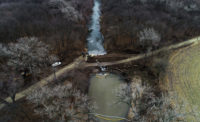
Those who build civil works underground aren't seen much by the public or by the industry's next generation. But this was not the case on April 12, when hundreds of engineering and construction college juniors and their contractor mentors—all in hardhats and vests—intersected with morning commuters in New York City's Grand Central Terminal before a visit to the huge tunneling project below.
The industry group descended 200 ft underground to tour the Metropolitan Transportation Authority's East Side Access rail-tunnel project, which will connect the Long Island Rail Road with Grand Central. The annual "Student Day" event is run by the Moles, the heavy-construction professionals group.
More than 425 students and faculty from 21 schools up to 150 miles away got a four-hour, close-up look at the job. The event has been a Moles staple since 1962, says Executive Director Gerard Carty.
"The 4 a.m. wake-up was well worth a day full of useful information and some spectacular sights. I had never heard of ground freezing before—it was fascinating," says engineering major Brian Wurster of Bucknell University, Lewisberg, Pa. "Real-life applications of our education allow us to make informed decisions about what we want to do after we graduate."
Adds Michaela LaPatin, also at Bucknell, "a career in construction means getting out of the office and applying our knowledge on something more than a piece of graph paper."
Mike Toole, Bucknell associate dean of civil-environmental engineering, says, "If one picture tells a thousand words, a few hours of quality time on a good construction site like East Side Access can provide insights and perspectives that would not be possible even after dozens of hours in a classroom."
Civil engineers have been one of the most widely recruited campus majors this year, believes Toole, who teaches the department's only construction course.
Tom Zimmie, engineering professor at Rensselaer Polytechnic Institute near Albany, says his 19 student visitors loved the tour, particularly the opportunity to meet practitioners. He says 25% of his students are women.
"I typically do not view my future in construction as a career in a male dominated industry," says LaPatin. "I like to think I view it just the same way any of my male classmates would. I learn the same material that they do now and I will eventually do the same work that they will do as well. The tour experience impacted me just the same."
LaPatin says she would like to pursue a career direction in commercial construction. "I see it as just wanting to be more detail oriented," she says. "I earned my LEED Green Associate this past December and I believe that while not all buildings need to be LEED certified or greater, a sustainable focus should always be a priority in a construction project."
Steve McKeegan, professor of construction technology and management at the State University of New York in upstate Delhi, says alumni who are Moles members have helped his program improve its curriculum in heavy construction.
Moles members who are "Student Day" veterans and have moved into key industry roles—such as Yonkers Contracting chief operating officer John Kolaya—see the value of the connections. He says the group's scholarship fund now exceeds $4 million.
"Before the Moles, I imagined pursuing a career as a structural engineer partnering with architects," says tour mentor Mitza Zobenica, an alumna who is a project superintendent for Skanska's Underpinning and Foundation unit. "I had not had any previous experience with the heavy civil, tunneling or foundation industry, and it was a revelation. I'm sure there are many students like me."
"I'm interested in working on projects that will truly have a positive impact on people's lives," says Luke Lombardi, also a Bucknell engineering major.
"Seeing the complexity of the East Side Access helped me imagine what it would be like to achieve an engineering feat of this magnitude."





Post a comment to this article
Report Abusive Comment